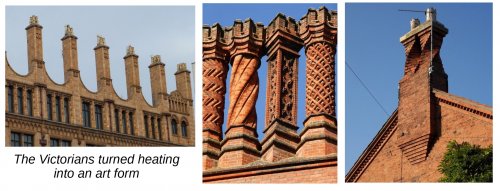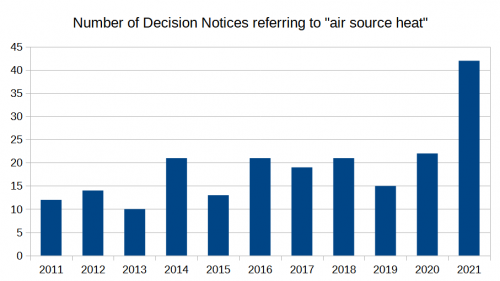Beautiful Infrastructure?
The National Planning Policy Framework now includes ‘beautiful’ in its definition of sustainable development (NPPF 8b). Meanwhile COP26 is focusing minds on replacing fossil fuels with renewable energy. Large schemes may have the luxury of considering ground source heat pumps, but for small schemes and single dwellings the most affordable and available solution at present is air source heat pumps, which tend to be rather ugly. With ‘local character’ at the forefront of Planning Inspectors’ minds, how can developers meet this challenge?
Beautiful buildings, attractive chimneys and ugly renewables
The Framework’s chapter on Design assumes that developers will meet the challenge, stating, “The creation of high quality, beautiful and sustainable buildings and places is fundamental to what the planning and development process should achieve” (NPPF 126). However the National Design Guide reflects the common approach that sees chimneys as helping, “to create a positive and interesting facade” while remaining entirely silent on the aesthetics of airsource heat pumps.
Planning’s approach to air source heat pumps
Planning appeals are rarely lost or won on their green credentials, whereas design is a key issue in many appeals. Renewable energy can sit awkwardly with traditional concepts of ‘character’ and ‘beauty’. This might resolve in one of two ways.
Local planning authorities might follow the path of ignoring heatpumps’ visual impact, like they ignored satellite dishes. Or they might think air source heat pumps should be resisted due to their visual impact, and assume that they will be replaced by other technologies. Unfortunately green hydrogen boilers won't help today's planning application and not every house has a suitable roof for solar power, so we come back to the conundrum of ugly air source heat pumps.
It is likely that many LPAs will cite the local community’s aspirations and refuse developments on design grounds. In any event, developers need to present a ‘beautiful’ development in order to comply with NPPF paragraphs 8b, 126 and 130.
If traditional architecture is deemed attractive, perhaps we should be learning how the Victorians turned necessary infrastructure into attractive features. Chimneys are a fine example of Victorian creativity. Perhaps heating engineers should be locked in a room with creative designers until they turn air source heat pumps into beautiful features that are an integral part of a building's design. 
Planning appeals and heat pumps
“Air source heat” is increasingly appearing on appeal Decision Notices, with this year to date already seeing a doubling in the number of appeals referring to air source heat pumps, usually an element of the development or as a planning condition.

As air source heat pumps become more common, their design issues are coming to the forefront. In a recent appeal (APP/N4720/C/21/3272756), Leeds City Council issued an enforcement notice requiring the removal of 2 air source heat pumps on the rear extension of a residential property. The main issue was the visual impact on the occupiers of a neighbouring dwelling. The Inspector noted that the, “units do have a somewhat overbearing impact on the occupiers of that house and garden. This is due to a combination of their, size, height, and positioning, relative to the pitch of the extension gable and their predominantly white colour. That contrasts markedly with the black finish of the extension and draws the eye.” The heat pumps were found to be in conflict with Local Plan policies and an adopted Householder Design Guide SPD that focused on residential amenity. In balancing the various considerations, the Inspector decided that, if a condition required the heat pumps to be painted black, they would, “not cause unacceptable harm” to the neighbours and would, “secure modest benefits in terms of energy efficiency”. The Inspector granted the appeal, subject to the air source heat pump being painted black to match the building behind.
Creative futures
In summary, the NPPF requires ‘beautiful’ buildings irrespective of the current ugliness of air source heat pumps. The Victorians rose to the challenge of integrating their heating infrastructure into the design of buildings, and so can we. Just as wind turbine designs have become more varied and elegant, air source heat pumps must now transform into building elements that contribute character and beauty to the overall design. The first architects to crack this one will surely win awards.
To view appeals of interest to you, visit our Homepage.

